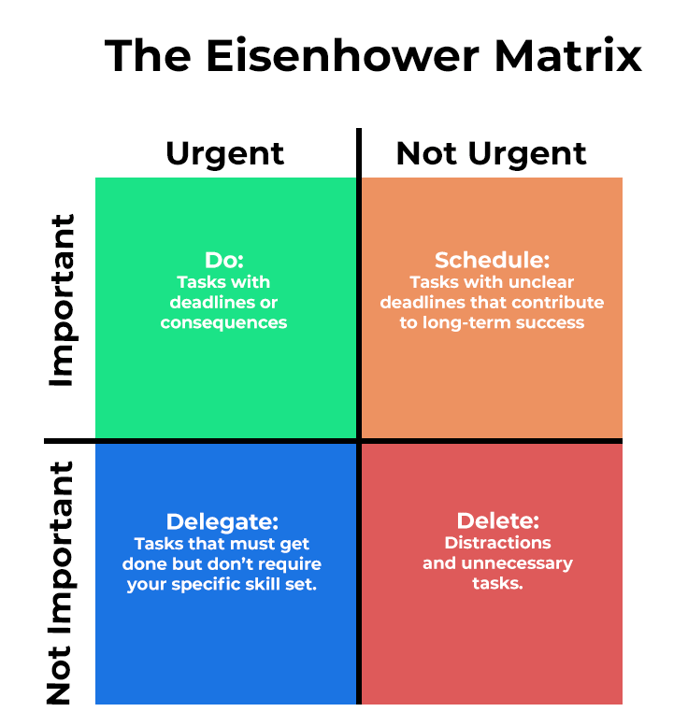The Eisenhower Matrix is a task management tool that helps prioritize tasks by urgency and importance, dividing them into four categories: tasks to do immediately, tasks to schedule, tasks to delegate, and tasks to eliminate.

Overview
The Eisenhower Matrix is a powerful tool for managing tasks by sorting them based on their urgency and importance. It divides tasks into four categories: tasks to do immediately, tasks to schedule for later, tasks to delegate, and tasks to eliminate. In this guide, we'll walk you through how to set up the Eisenhower Matrix and offer some tips on effective task prioritization.
Creating a to-do list is the first step in staying organized. But how do you decide which tasks to prioritize when you can't complete everything in one day? By mastering prioritization, you can boost your productivity and focus on the tasks that matter most.
The Eisenhower Matrix helps you assess tasks by distinguishing between what's urgent and what's important, allowing you to build a more organized workflow. Let’s dive into how to set it up and use it to manage your workload efficiently.
What is the Eisenhower Matrix?
Named after Dwight D. Eisenhower, the 34th President of the United States, the Eisenhower Matrix helps you prioritize tasks by urgency and importance. Eisenhower himself famously said, “I have two kinds of problems, the urgent and the important. The urgent are not important, and the important are never urgent.”
The Matrix, developed by Stephen Covey in his book The 7 Habits of Highly Effective People, is also referred to as the Urgent-Important Matrix. This tool organizes tasks into four key areas: tasks to tackle now, tasks to plan for later, tasks to delegate, and tasks to remove from your list.
Differentiating Between Urgent and Important
While “urgent” and “important” seem similar, understanding the distinction is essential to effectively use the Eisenhower Matrix. By recognizing which tasks are truly urgent and which are important, you can prioritize your work more strategically.
- Urgent Tasks: These demand immediate attention and have a clear deadline or consequence if not completed. Delaying them increases stress and the risk of burnout.
- Example: Completing a project with a tight deadline, addressing an urgent client issue, or fixing a major problem at home.
- Important Tasks: These contribute to your long-term goals but don’t necessarily need to be addressed immediately. While they aren't urgent, they are key to achieving your objectives.
- Example: Planning a long-term project, expanding your professional network, or keeping up with regular maintenance tasks.
How to Set Up the Eisenhower Matrix
The Eisenhower Matrix separates tasks into four quadrants, each representing a different type of action:
Quadrant 1: Do
These are tasks that are both urgent and important. These tasks should be addressed immediately because they have both immediate deadlines and long-term consequences.
- Example: Completing a client presentation due today or resolving an urgent technical issue.
Quadrant 2: Schedule
These tasks are important but not urgent. They should be planned for later. These tasks contribute to long-term goals but don't need immediate attention, so you can schedule them for a future time.
- Example: Signing up for a professional development course or preparing for a strategic meeting.
Quadrant 3: Delegate
These tasks are urgent but not important. They need to be completed quickly but don’t contribute to your long-term success, so it’s best to delegate them to others.
- Example: Answering routine emails or setting up meetings that don't require your direct involvement.
Quadrant 4: Eliminate
Tasks that are neither urgent nor important should be removed from your to-do list. These are distractions that only waste your time and prevent you from focusing on more valuable activities.
- Example: Attending unnecessary meetings or dealing with minor administrative tasks.
Tips for Prioritizing Tasks
While using the Eisenhower Matrix is an excellent method for sorting your tasks, here are a few additional tips that can help you further refine your prioritization process:
-
Color-Code Tasks
Use color coding to visually categorize your tasks based on priority. Assign colors such as:- Green for high priority
- Yellow for medium priority
- Blue for low priority
- Red for tasks that aren’t a priority at all
-
Limit Tasks to Ten Per Quadrant
To avoid overwhelming yourself, try to limit the tasks in each quadrant to just 10 items. This helps keep the Matrix manageable and ensures you're focusing on what truly matters. -
Separate Personal and Professional Lists
Create separate Eisenhower Matrices for your work and personal tasks. This will help you allocate appropriate resources and time to each area without the overlap. -
Eliminate Before Prioritizing
Before prioritizing, eliminate tasks that don't contribute to your goals. This step helps clear unnecessary clutter and makes the remaining tasks easier to prioritize.
Eisenhower Matrix Examples
Here are some examples to help you better understand how tasks might fit into each quadrant:
-
Quadrant 1: Do
- Completing a project with a tight deadline
- Responding to urgent client inquiries
- Fixing a system error or technical problem
-
Quadrant 2: Schedule
- Enrolling in a professional course
- Attending a networking event
- Improving a personal project
-
Quadrant 3: Delegate
- Uploading blog content
- Transcribing meeting notes
- Answering non-urgent emails
-
Quadrant 4: Eliminate
- Non-essential meetings
- Work about work tasks
- Status updates and approval processes that don't add value
By effectively using the Eisenhower Matrix, you can optimize your productivity and ensure you’re focusing on the tasks that really matter. Remember to adjust and revisit your priorities regularly to stay on track and maintain balance in your professional and personal life.
